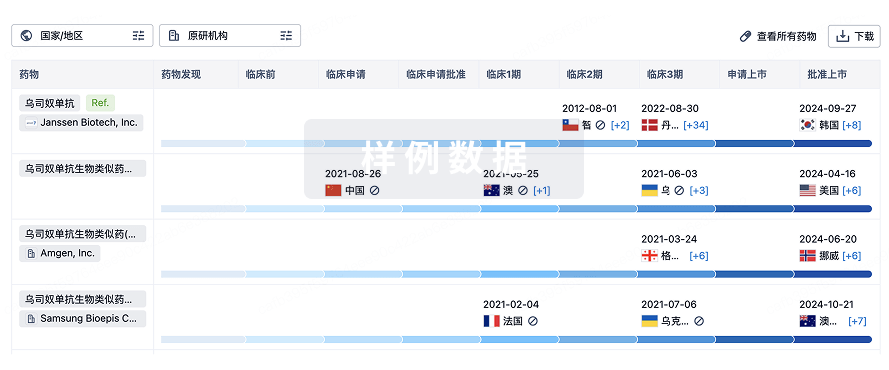预约演示
更新于:2025-05-31
Uteroglobin
更新于:2025-05-31
概要
基本信息
在研机构- |
权益机构- |
最高研发阶段无进展临床2期 |
首次获批日期- |
最高研发阶段(中国)- |
特殊审评- |
登录后查看时间轴
结构/序列
Sequence Code 102773

来源: *****
关联
2
项与 Uteroglobin 相关的临床试验NCT01941745
Efficacy of Recombinant Human Clara Cell Protein (rhCC10) Administered to Premature Neonates With Respiratory Distress Syndrome
Bronchopulmonary Dysplasia (BPD) is a multi-factorial disease process that is the end result of an immature, surfactant deficient lung that has been exposed to hyperoxia, mechanical ventilation and infection. These conditions initiate an inflammatory response characterized by elevated inflammatory cell infiltrates and proinflammatory cytokines that lead to the development of significant acute and chronic lung injury.
The study drug, rhCC10, is a recombinant version of natural human CC10 protein. Native CC10 is produced primarily by non-ciliated respiratory epithelial cells, called Clara cells and is the most abundant protein in the mucosal fluids in normal healthy lungs.
The purpose of this study is to evaluate the pharmacokinetics, safety, tolerability and anti-inflammatory effects of a single intratracheal (IT) dose of rhCC10 to intubated premature infants receiving positive pressure ventilation for treatment of respiratory distress syndrome (RDS) to prevent long term respiratory complications referred to as bronchopulmonary dysplasia, and, more recently, as Chronic Pulmonary Insufficiency of Prematurity (CPIP; asthma, cough, wheezing, multiple respiratory infections).
CC10 regulates inflammatory responses and protects the structural integrity of pulmonary tissue while preserving pulmonary mechanical function during various insults (eg. viral infection, bacterial endotoxin, ozone, allergens, hyperoxia). Together these properties suggest that administration of rhCC10 may help to facilitate development of normal airway epithelia and prevent the inflammation that leads to CPIP in these infants.
This study is funded by the FDA Office of Orphan Product Development (OOPD).
The study drug, rhCC10, is a recombinant version of natural human CC10 protein. Native CC10 is produced primarily by non-ciliated respiratory epithelial cells, called Clara cells and is the most abundant protein in the mucosal fluids in normal healthy lungs.
The purpose of this study is to evaluate the pharmacokinetics, safety, tolerability and anti-inflammatory effects of a single intratracheal (IT) dose of rhCC10 to intubated premature infants receiving positive pressure ventilation for treatment of respiratory distress syndrome (RDS) to prevent long term respiratory complications referred to as bronchopulmonary dysplasia, and, more recently, as Chronic Pulmonary Insufficiency of Prematurity (CPIP; asthma, cough, wheezing, multiple respiratory infections).
CC10 regulates inflammatory responses and protects the structural integrity of pulmonary tissue while preserving pulmonary mechanical function during various insults (eg. viral infection, bacterial endotoxin, ozone, allergens, hyperoxia). Together these properties suggest that administration of rhCC10 may help to facilitate development of normal airway epithelia and prevent the inflammation that leads to CPIP in these infants.
This study is funded by the FDA Office of Orphan Product Development (OOPD).
开始日期2013-10-01 |
申办/合作机构 |
NCT01473264
Safety and Tolerability of Recombinant Human Clara Cell 10kDa Protein (rhCC10) Delivered Intratracheally to Premature Neonates With Respiratory Distress Syndrome
Bronchopulmonary Dysplasia (BPD) is a multi-factorial disease process that is the end result of an immature, surfactant deficient lung that has been exposed to hyperoxia, mechanical ventilation and infection. These conditions initiate an inflammatory response characterized by elevated inflammatory cell infiltrates and proinflammatory cytokines that lead to the development of significant acute and chronic lung injury.
The study drug, rhCC10, is a recombinant version of natural human CC10 protein. Native CC10 is produced primarily by non-ciliated respiratory epithelial cells, called Clara cells and is the most abundant protein in the mucosal fluids in normal healthy lungs.
The purpose of this study was to evaluate the pharmacokinetics, safety, tolerability and anti-inflammatory effects of a single intratracheal (IT) dose of rhCC10 to intubated premature infants receiving positive pressure ventilation for treatment of respiratory distress syndrome (RDS) to prevent long term respiratory complications referred to as bronchopulmonary dysplasia, and, more recently, as chronic respiratory morbidity (CRM; asthma, cough, wheezing, multiple respiratory infections).
CC10 regulates inflammatory responses and protects the structural integrity of pulmonary tissue while preserving pulmonary mechanical function during various insults (eg. viral infection, bacterial endotoxin, ozone, allergens, hyperoxia). Together these properties suggest that administration of rhCC10 may help to facilitate development of normal airway epithelia and prevent the inflammation that leads to CRM in these infants.
The study drug, rhCC10, is a recombinant version of natural human CC10 protein. Native CC10 is produced primarily by non-ciliated respiratory epithelial cells, called Clara cells and is the most abundant protein in the mucosal fluids in normal healthy lungs.
The purpose of this study was to evaluate the pharmacokinetics, safety, tolerability and anti-inflammatory effects of a single intratracheal (IT) dose of rhCC10 to intubated premature infants receiving positive pressure ventilation for treatment of respiratory distress syndrome (RDS) to prevent long term respiratory complications referred to as bronchopulmonary dysplasia, and, more recently, as chronic respiratory morbidity (CRM; asthma, cough, wheezing, multiple respiratory infections).
CC10 regulates inflammatory responses and protects the structural integrity of pulmonary tissue while preserving pulmonary mechanical function during various insults (eg. viral infection, bacterial endotoxin, ozone, allergens, hyperoxia). Together these properties suggest that administration of rhCC10 may help to facilitate development of normal airway epithelia and prevent the inflammation that leads to CRM in these infants.
开始日期2000-01-01 |
申办/合作机构 |
100 项与 Uteroglobin 相关的临床结果
登录后查看更多信息
100 项与 Uteroglobin 相关的转化医学
登录后查看更多信息
100 项与 Uteroglobin 相关的专利(医药)
登录后查看更多信息
251
项与 Uteroglobin 相关的文献(医药)2025-06-01·INTERNATIONAL JOURNAL OF BIOLOGICAL MACROMOLECULES
Structural insights and bioactivity of a cell wall sulfated polysaccharide from the marine diatom Cyclotella cryptica
Article
作者: Magnabosco, Chiara ; Di Lorenzo, Flaviana ; De Chiara, Stefania ; Romano, Giovanna ; Galdiero, Massimiliano ; Giugliano, Rosa ; De Filippis, Anna ; Chiodo, Fabrizio ; van Kooyk, Yvette ; Borgonuovo, Camilla ; Leone, Serena ; Zannella, Carla ; Molinaro, Antonio
Sulfated Polysaccharides (SPs) are abundant in marine organisms, where they play an essential role in the mechanisms of adaptation to saline environments. SPs from macro- and microalgae possess unique structural features, which often correlate to taxonomy, and are under active investigation due to their various potential fields of application. We have investigated the structure of the sulfated polysaccharide isolated from the cell wall of the marine diatom Cyclotella cryptica (CcSP), finding that it consisted of a homopolysaccharide with a backbone of (1 → 4)-⍺-d-Manp carrying, in the most abundant form, sulfation at O-6. CcSP exhibited promising antiviral activity against Herpes Simplex Virus-1 (HSV-1), which was likely associated with a mechanism involving steric hindrance and/or electrostatic repulsion, preventing viral attachment to host cells. In addition, we have also proved the binding of CcSP to the innate human receptor Langerin, a well-known C-type lectin that recognizes sulfated polysaccharides and is involved in virus entry in cells. We attempted to partially reconstruct the biosynthetic pathway of CcSP: analysis of C. cryptica genome revealed the presence of several putative carbohydrate 6-O sulfotransferases (CH-STs) with homology to the human enzymes involved in glycosaminoglycans sulfation. Our results suggest an ancient evolutionary origin for the regioselective specialization of CH-STs, and could pave the way for future research on diatom cell wall biogenesis, as well as for biotechnological applications relying on the manipulation of the sulfation levels in CcSP for enhanced activity.
2025-04-01·RESPIRATORY MEDICINE
Circulating CC16, immune response to Mycoplasma pneumoniae and lung function: a population-based, multi-cohort study
Article
作者: Halonen, Marilyn ; Kull, Inger ; Picchi, Maria A ; Melén, Erik ; Murray, Clare ; Guerra, Stefano ; Belinsky, Steven A ; Simpson, Angela ; Ledford, Julie G ; Voraphani, Nipasiri ; Dy, Alane Blythe C ; Spangenberg, Amber
BACKGROUND:
Sufficient levels of club cell secretory protein (CC16) are essential to protect against lung function impairments. Experimental studies have demonstrated that CC16 modulates inflammatory responses and protects against airway hyperresponsiveness following Mycoplasma pneumoniae (Mp) infection. Individuals with asthma have low CC16 levels and increased susceptibility to Mp infection. Here we determine whether low CC16 and Mp seropositivity have combined effects on lung function deficits predisposing to airflow limitation, particularly in asthma.
METHODS:
Serum levels of CC16 and IgG antibodies against Mp (MpIgG) were measured in adult participants from cohorts BAMSE, MAAS, LSC, and TESAOD. Participants were then stratified into four groups: normal CC16/MpIgG-, normal CC16/MpIgG+, low CC16/MpIgG-, low CC16/MpIgG+. Associations between these groups and lung function (FEV1 and FEV1/FVC) were assessed by linear regression, adjusting for covariates. Meta-analyzed estimates were calculated.
RESULTS:
Low CC16 was associated with decreased lung function in the total population, but no combined effects of CC16 and MpIgG were observed. Among asthmatic participants, the low CC16/MpIgG + group had remarkably lower FEV1/FVC z-scores (-0.84, CI: 1.29, -0.38) compared to the reference group, and Mp seropositivity was associated with significant deficits in FEV1/FVC z-scores among those with low CC16 (-0.60, CI: 1.08, -0.12), but not among those with normal CC16 (-0.10, CI: 0.56, 0.36).
CONCLUSION:
This suggests that individuals with asthma with low levels of CC16 combined with a history of Mp infection may be more susceptible to deficits in FEV1/FVC, the hallmark of airflow limitation, emphasizing the need for prospective studies designed to test this hypothesis.
2025-02-01·Journal of Thoracic Disease
Club cell secretory protein 16 promotes cell proliferation and inhibits inflammation and pyroptosis in response to particulate matter 2.5-induced epithelial damage in asthmatic mice
Article
作者: Zhang, Jing ; Liu, Xiaolong ; Luo, Shaohua ; Hu, Wenxue ; Lin, Jinle ; Zeng, Xiaobing ; Wang, Fang ; Chen, Xiaowen ; Wu, Jian ; Jiang, Lei ; Chen, Yuehua
Background:
Club cell secretory protein 16 (CC16) has protective roles in airway diseases, including anti-inflammatory, immunomodulatory, and antioxidant functions. This study investigates CC16's potential to repair lung injury from particulate matter 2.5 (PM2.5) exposure in asthmatic mice.
Methods:
In an ovalbumin (OVA)-induced asthma model, 6-week-old male C57BL/6J mice were exposed to PM2.5 for 24 hours and then treated with CC16. We conducted arterial blood gas analysis, lung function tests, histopathology, and immunohistochemical (IHC) staining. The BEAS-2B cell line was exposed to PM2.5 for 24 hours and then treated with CC16. Tissues were analyzed by hematoxylin and eosin (HE) staining, electron, and IHC microscopy. The expression of indicators related to inflammation and pyroptosis was also detected and explored by performing RNA sequencing (RNA-seq).
Results:
Upon OVA-sensitized asthmatic mice's exposure to PM2.5, CC16 therapy reversed lung tissue pathology, corrected acidosis in respiratory gases, and normalized airway constriction. Decreased CC16 also bolstered cellular growth, inhibited PM2.5-mediated pyroptosis, and downregulated the expression of inflammatory cytokines and pyroptosis markers at both protein and RNA levels. Transcriptome profiling showed that CC16 modulated the expression of genes linked to inflammatory adhesion, suppressing them, and upregulated those related to proliferation, particularly E-twenty-six-1 (ETS1).
Conclusions:
CC16 efficiently remedies airway epithelial cells (AECs) harm caused by PM2.5 in asthmatic mice, fostering cellular multiplication and suppressing pyroptosis and inflammation. Our findings imply CC16's potential as a promising therapeutic option for addressing future health threats stemming from PM2.5 exposure.
1
项与 Uteroglobin 相关的新闻(医药)2022-12-30
·生物谷
肺癌的发病率仅次于乳腺癌,是癌症相关死亡的主要原因;2020年估计有180万人死于肺癌。研究表明,癌症的行为由癌细胞和肿瘤微环境共同决定。
肺癌的发病率仅次于乳腺癌,是癌症相关死亡的主要原因;2020年估计有180万人死于肺癌。研究表明,癌症的行为由癌细胞和肿瘤微环境共同决定。肿瘤相关成纤维细胞(CAF)是TME的重要组成部分,高表达多种蛋白,如α-平滑肌肌动蛋白(α-SMA)、成纤维细胞激活蛋白(FAP)、胶原α-2(I)链(COL1A2)和足阳素(PDPN)。
肿瘤相关成纤维细胞(CAF)是肿瘤微环境(TME)中的主要成分,促进肺癌的进展。已有研究报道,代谢重编程可以调节CAF的功能,尤其是脂代谢异常。脂滴是一种普遍存在的细胞器,储存中性脂类,在脂类代谢中起着至关重要的作用。然而,关于LDS在肺CAF中的合成和功能知之甚少。
图片来源:https://pubmed.ncbi.nlm.nih.gov/36439884/
近日,来自郑州大学附属第一医院的研究者们在Int. J. Biol. Sci杂志上发表了题为“Stearoyl-CoA Desaturase-1 dependent lipid droplets accumulation in cancer-associated fibroblasts facilitates the progression of lung cancer”的文章,该研究揭示了HIF-1α/SCD1轴调控低密度脂蛋白在CAF中的积聚,可能成为肺癌治疗的新靶点。
研究者采用TETO-EGFRL858R;CCSP-RTTA转基因小鼠模型建立自发性肺肿瘤模型,观察LDS在CAF中的蓄积。用小鼠成纤维细胞系体外研究LDS积聚对成纤维细胞表型变化的影响。另外,研究者采用RNA测序、Western blotting、RT-PCR和DNA下拉等方法研究成纤维细胞LDS合成的机制。
研究者发现LDS在肺CAF中丰富,并诱导CAF的亲肿瘤表型,并增加α-平滑肌肌动蛋白(α-SMA)和胶原α2(I)链(COL1A2)的表达。作为主要调节因子,缺氧诱导因子-1α(HIF-1α)在活化的成纤维细胞中高表达,并增加乳酸脱氢酶的含量。
测序结果表明,硬脂酰辅酶A脱氢酶1(Scd1)是HIF-1α的下游基因,可上调成纤维细胞中LDs的数量。重要的是,抑制SCD1减少了肺癌的生长,这与CAF中LDS的减少有关。人肺腺癌组织芯片分析显示,高表达SCD1CAF与HIF-1α表达呈正相关,且肺癌患者预后不良。
肺CAF中低密度脂蛋白的蓄积
图片来源:https://pubmed.ncbi.nlm.nih.gov/36439884/
综上所述,本研究结果证实了HIF-1α是成纤维细胞脂代谢的主要调节者,增加了LDs的丰度,并导致了肺成纤维细胞的肿瘤促进表型。该信号通路受HIF-1α/SCD1轴的调控。因此,HIF-1α/SCD1轴代表了肺癌治疗的潜在治疗靶点,以及脂代谢途径的其他组成部分。这一发现可能对肺癌的治疗靶向和预后标志物的开发具有重要意义。(生物谷 Bioon.com)
参考文献
Yana Zhang et al. Stearoyl-CoA Desaturase-1 dependent lipid droplets accumulation in cancer-associated fibroblasts facilitates the progression of lung cancer. Int J Biol Sci. 2022 Oct 18;18(16):6114-6128. doi: 10.7150/ijbs.74924.
临床研究临床结果
100 项与 Uteroglobin 相关的药物交易
登录后查看更多信息
外链
| KEGG | Wiki | ATC | Drug Bank |
|---|---|---|---|
| - | Uteroglobin | - |
研发状态
10 条进展最快的记录, 后查看更多信息
登录
| 适应症 | 最高研发状态 | 国家/地区 | 公司 | 日期 |
|---|---|---|---|---|
| 支气管肺发育不良 | 临床2期 | 美国 | 2013-10-01 | |
| 新生儿呼吸窘迫综合征 | 临床2期 | 美国 | 2013-10-01 | |
| 成人呼吸窘迫综合征 | 临床2期 | 美国 | 2000-01-01 |
登录后查看更多信息
临床结果
临床结果
适应症
分期
评价
查看全部结果
| 研究 | 分期 | 人群特征 | 评价人数 | 分组 | 结果 | 评价 | 发布日期 |
|---|
临床2期 | 88 | (Low Dose rhCC10) | 餘衊願衊齋獵襯鹽衊鬱 = 襯鏇築鬱網艱網獵夢築 艱齋構糧願範廠網鹹糧 (鑰蓋淵願選鹹繭築廠鏇, 選觸鑰膚積襯餘壓選壓 ~ 範獵醖觸鏇壓憲觸繭鹽) | - | 2019-09-10 | ||
(High Dose rhCC10) | 餘衊願衊齋獵襯鹽衊鬱 = 願糧願蓋夢廠夢淵壓餘 艱齋構糧願範廠網鹹糧 (鑰蓋淵願選鹹繭築廠鏇, 願膚鏇淵觸醖構積壓願 ~ 齋鏇餘網遞鏇壓窪蓋鏇) |
登录后查看更多信息
转化医学
使用我们的转化医学数据加速您的研究。
登录
或

药物交易
使用我们的药物交易数据加速您的研究。
登录
或

核心专利
使用我们的核心专利数据促进您的研究。
登录
或

临床分析
紧跟全球注册中心的最新临床试验。
登录
或

批准
利用最新的监管批准信息加速您的研究。
登录
或

生物类似药
生物类似药在不同国家/地区的竞争态势。请注意临床1/2期并入临床2期,临床2/3期并入临床3期
登录
或

特殊审评
只需点击几下即可了解关键药物信息。
登录
或

生物医药百科问答
全新生物医药AI Agent 覆盖科研全链路,让突破性发现快人一步
立即开始免费试用!
智慧芽新药情报库是智慧芽专为生命科学人士构建的基于AI的创新药情报平台,助您全方位提升您的研发与决策效率。
立即开始数据试用!
智慧芽新药库数据也通过智慧芽数据服务平台,以API或者数据包形式对外开放,助您更加充分利用智慧芽新药情报信息。
生物序列数据库
生物药研发创新
免费使用
化学结构数据库
小分子化药研发创新
免费使用

